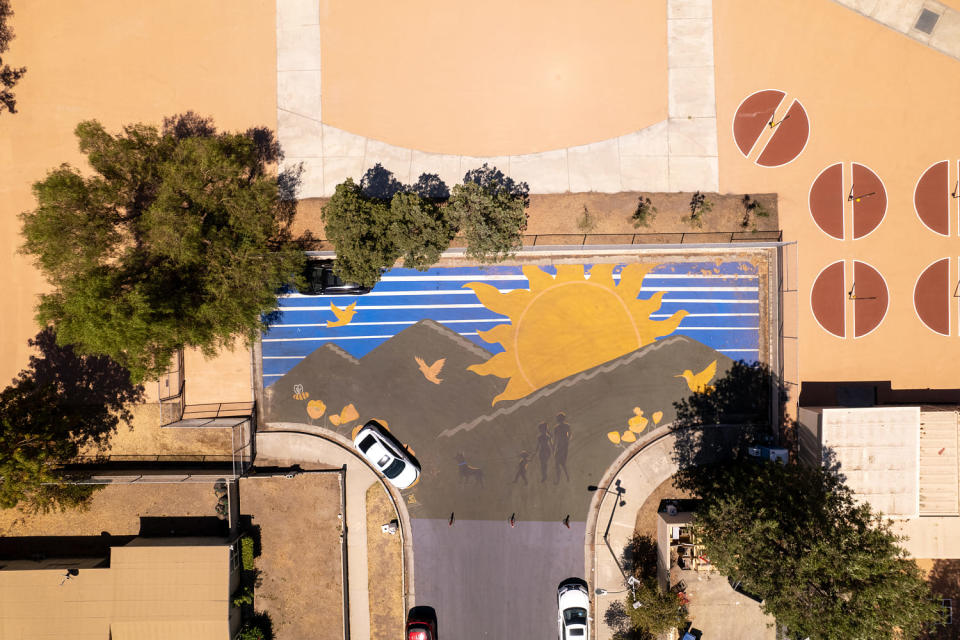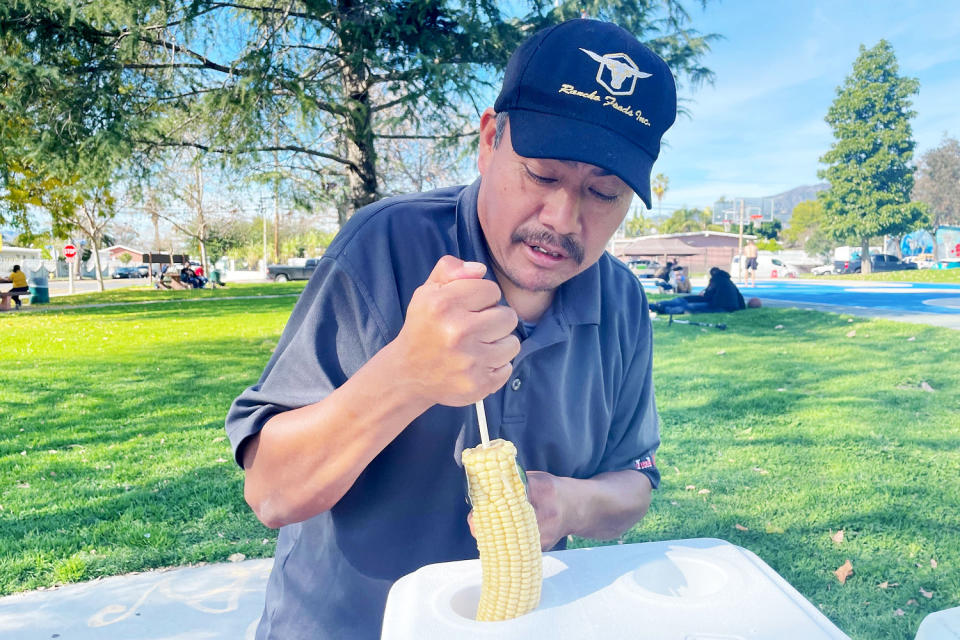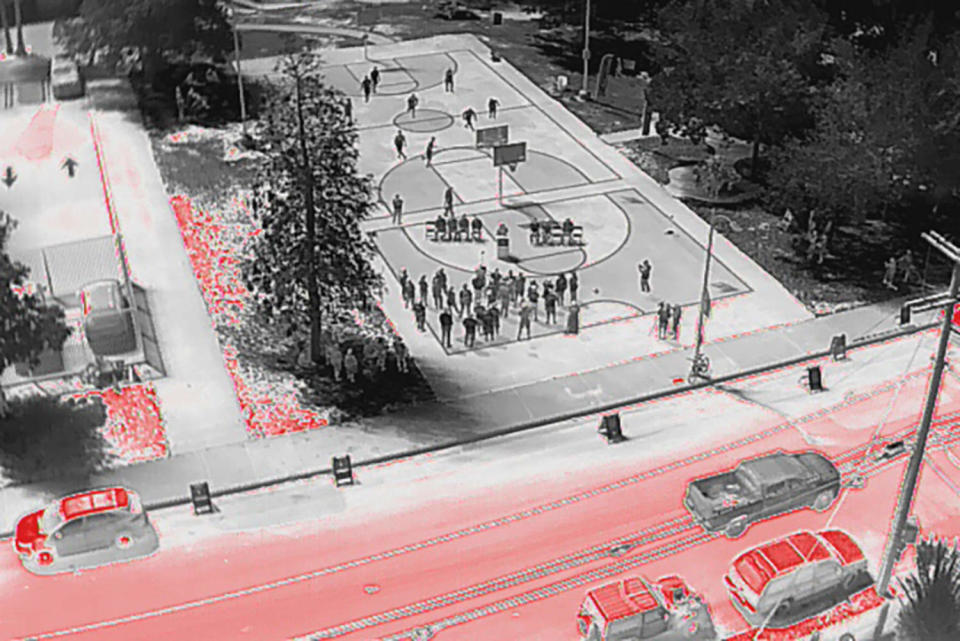LOS ANGELES – Street vendor José Damián has lived in the Los Angeles neighborhood of Pacoima for the past five years and has felt the temperature hit 105 degrees as he pushes his cart of Mexican street snacks and shaves ice in the midday sun.
But the heat didn’t stop him from doing his job until last summer.
On his way to Sara Coughlin Elementary School, he was sweating profusely and felt dizzy. He decided to get checked in a hospital.
“All the salt in my body was exhausted,” said Damián, who drank about 15 bottles of water that day. “Now I bring my Gatorades. I don’t walk much anymore. I stop at certain spots with shade.”
Pacoima residents have long suffered from high temperatures. Cecilia Zepeda, 60, said the heat can be unbearable even at night. Georginna Carrasco, who grew up in the neighborhood and now has two children, said she usually takes three showers a day and keeps the lights on in her apartment to cool down. She sometimes has to make the difficult decision to keep the AC off during the summer because it is too expensive.
“It feels like it gets hotter and hotter every year, but growing up in the San Fernando Valley, you’re used to it,” Carrasco said.
In California, the death rate for heat-related deaths was about 4.2 per 1 million people in 2022 – the highest rate in two decades outside of the historic North American heat wave of 2006. And the communities low-income communities of color are most at risk. like Pacoima.
A 2021 study of satellite imagery found that California metro areas had greater temperature differences between the poorest and wealthiest neighborhoods than any other state in the Southwest, with tree canopy unevenly distributed across Los Angeles County. The study also found that majority Latino neighborhoods in the Los Angeles area, like Pacoima, were 6.7 degrees warmer than neighborhoods with few Latino residents.
Pacoima is among the hottest neighborhoods in Los Angeles. Temperatures in what is known as “The Valley” are warmer than elsewhere in the city, but Pacoima also lacks tree cover and has huge public housing complexes that have been shown to heat the area.
The largely working-class neighborhood of about 75,000 has historically been impacted by numerous polluting industries such as manufacturing, highway construction, nearby Whiteman Airport and the Metrolink line. Pollutants such as these only further affect health variations and cause heat-related illnesses.
In recent years, a coalition of non-profits, community organizations and the office of Pacoima Councilmember Monica Rodriguez have put together a plan to cool the neighborhood: a multi-year and multi-phase project that was announced in 2018. It began with the resurfacing of 18 city blocks with its sun shield -expressive that spreads heat. In partnership with roofing manufacturer GAF, Pacoima’s “cool pavement” project not only reduces the heat, it engages the community with colorful paving and vibrant murals.

The first cool sidewalks were laid in July 2022 across the 10 city blocks most frequented by children and seniors, including a basketball court and elementary school playground. The second phase of the project extended the cool walkways by another eight blocks.
The next step will be a cool roof test, with GAF retrofitting a few houses and more to come if the test is successful. Future steps may include planting more trees and installing solar shingles on homes and businesses.
“Cool sidewalks aren’t the only solution we’re advocating for with Climate Resolve, but it’s a solution we could use in the short term,” said Kristopher Eclarino, the nonprofit’s project manager who helped with logistics, research and coordinating data measurement for the public. cool paths. “Depending on how many trees are planted, it may take years for them to mature to provide a shade canopy that can also cool neighborhoods.”
Measuring the impact
A year after the first cool pavements were installed, the researchers found that the new surfaces had a significant effect on reducing the surface temperature. On sunny days, there was an overall 10-degree drop in surface temperature and a 2-degree drop in ambient temperature, meaning the air feels cooler closer to the ground. On very hot days, the average air temperature dropped by 3.5 degrees. One of the most surprising effects was that an area near where the paths were laid felt a slight cooling effect due to normal winds.
Some Pacoima residents said they haven’t noticed the effects of the cooling sidewalks, and some wish they were expanded. One of the areas where Damian sells his snacks is without reflective coatings.
Others felt the changes. Andres De La Hoya, senior director of recreation for the city parks department that oversees the Hubert H. Humphrey Recreation Center, said he was skeptical about the cool trails but was excited to install them after seeing the positive effects. . It makes a “huge difference” when he walks in areas of Pacoima that don’t have great trails, he said. “You sweat a lot more.”


Melanie Paola Torres, organizing manager at Pacoima Beautiful, a women-led nonprofit that worked on the project, said she and her colleagues heard positive feedback as they canvassed the neighborhood to help with education and community involvement. in their plans. Some residents did not know what “heat stress” is and how it affects the body, and were excited about the changes. One mom told Torres that the soles of her feet didn’t burn from the heat after laying down the cool paths in the park.
“All the positive results have led to increased demand from local residents for more pavements and public spaces,” Eclarino said. “We heard from community members that it feels cooler in their neighborhoods, with some families noticing that they could get outside more and enjoy the shared spaces together.”
The need for a ‘solutions toolbox’
More than 181 miles of cool sidewalks have been laid in Los Angeles since 2017, including in the neighborhoods of East Hollywood, Koreatown, Wilmington and Lake Balboa. While the cool trails are likely to be successful, organizers realize that tackling Pacoima’s heat is just the beginning.
“We know that coatings are not a silver bullet,” Eclarino said. “Tackling urban heat at a community level will require a toolbox of shade and nature-based solutions.”


In partnership with the Santa Monica Mountain Conservancy, Council Member Rodriguez and her staff are working toward expanding park space in Pacoima and the surrounding neighborhoods in the San Fernando Valley. His office has already opened a new park in nearby Sylmar and more trees have been planted in the area.
Another community success was the movie nights at the nearby Hansen Dam Aquatic Center, the nation’s largest municipal swimming pool. Screenings of movies like “Finding Nemo” and “Lilo & Stitch” have drawn more than 2,000 people, according to Rodriguez, a lifelong Pacoima resident. “My child was a fish because we had to escape the heat,” she said. “And many of the residents, they use our local pools for that reason.”
Pacoima Beautiful’s Torres is still optimistic about what her group and other community organizers are doing to make life more comfortable in her neighborhood.
“There are many things that burden us here,” she said, “but we are a community full of resilient people.”An earlier version of this article was first published in NBCUAcademy.com’s Storytellers.
For more from NBC Latino, sign up for our weekly newsletter.
This article was originally published on NBCNews.com